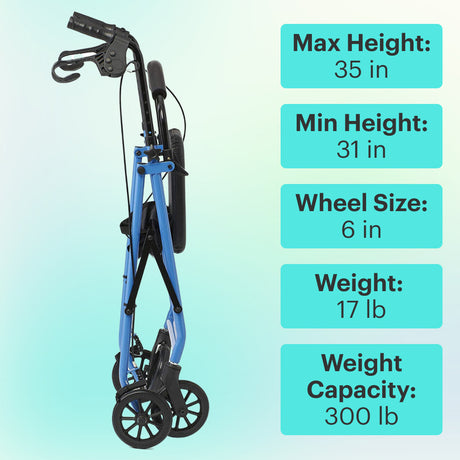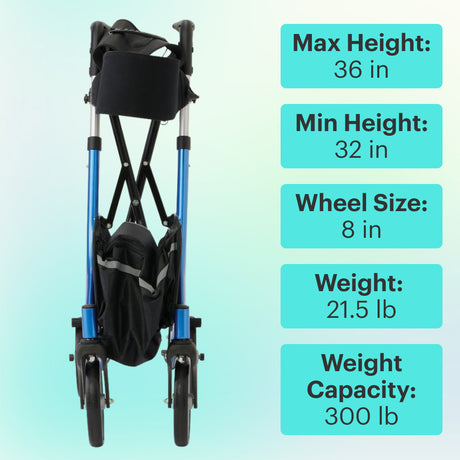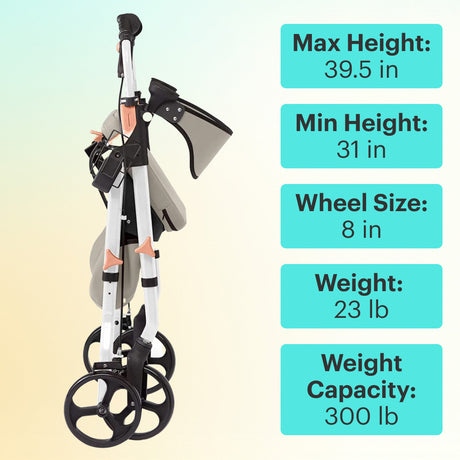Navigating through the myriad of mobility aids available can be daunting. Among the most common tools designed to enhance independence and safety are rollators and walkers. This comprehensive guide delves into the nuances between these aids, offering insights to help you make an informed decision tailored to your lifestyle and mobility needs.
What’s the Difference Between a Rollator and a Walker?
The primary difference lies in their design; walkers are simple frames with four legs that you lift to move forward, while rollators, often referred to as rolling walkers, come equipped with wheels on all legs and typically feature a seat and brakes. This fundamental distinction significantly impacts their usage, maneuverability, and suitability for various environments and individual needs.
Rollator vs Walker - Let’s Compare
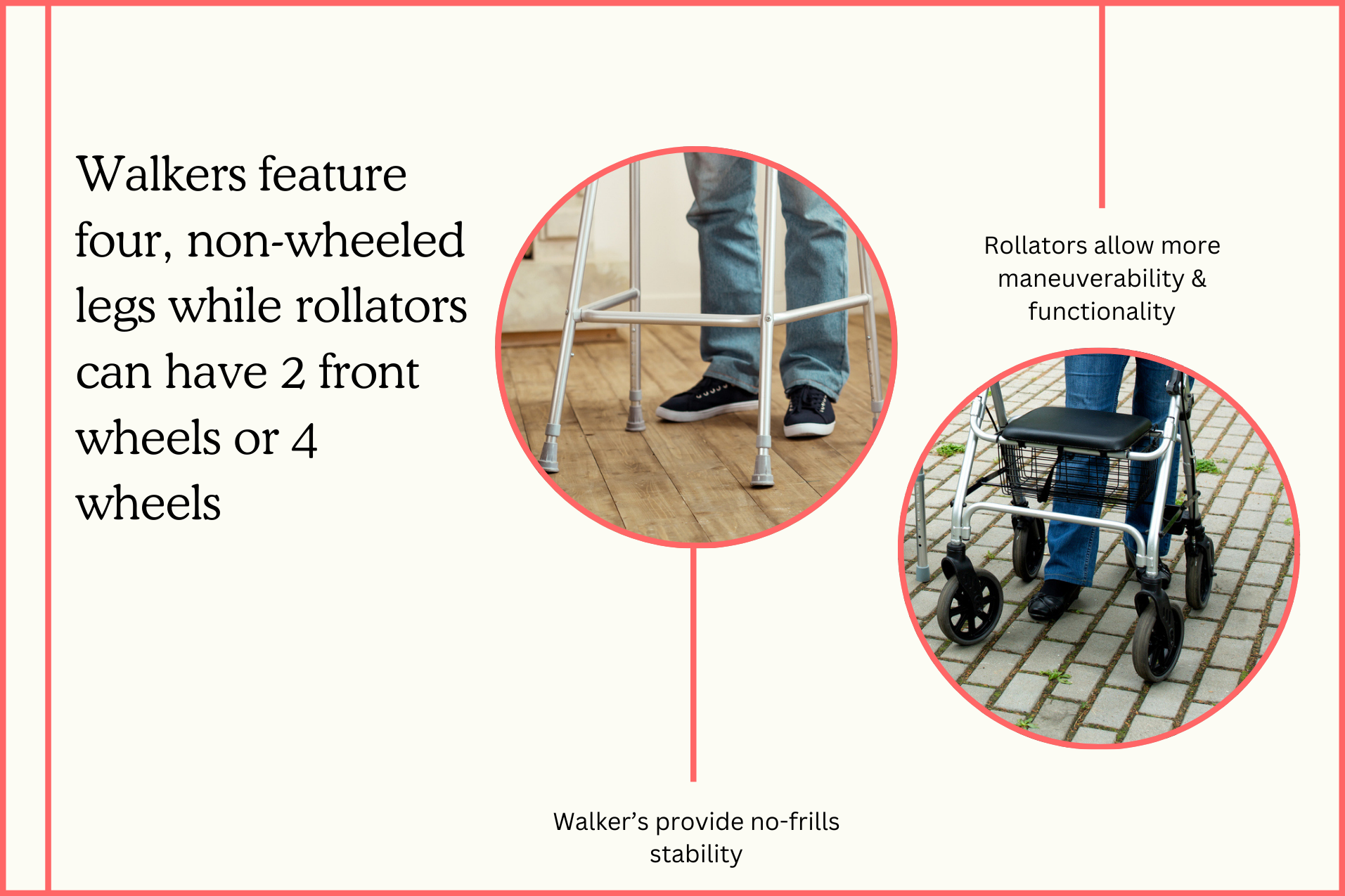
Design and Structure
Walkers present a no-frills design, focusing primarily on stability. They're lightweight and foldable, making them easy to transport and store. In contrast, rollators offer a blend of support and mobility thanks to their wheeled design. The inclusion of a seat and storage options such as baskets or pouches enhances their functionality, making them a versatile choice for active individuals.
Maneuverability and Stability
The choice between a walker and a rollator often comes down to the user's mobility and strength. Standard walkers provide unparalleled stability for those who need significant support, especially in lifting and moving the frame. Rollators, with their easy-to-maneuver wheels, are ideal for individuals who can walk but need occasional support and the option to stop and rest.
Ease of Use Indoors and Out
When considering where the mobility aid will be used most frequently, it's essential to note that walkers, with their slim profile, are well-suited for navigating narrow indoor spaces and tight spaces. Rollators, while also versatile indoors, excel in outdoor settings. Their wheels effortlessly handle varied terrains, from city sidewalks to park trails, offering users a greater sense of freedom.
Adjustability
Both walkers and rollators come with adjustable features to accommodate users of different heights and weights, but rollators often edge out with more customization options. The height of handles, the depth of the seat, and even the tension of the brakes can be tailored, ensuring a comfortable and safe experience.
Additional Features and Accessories
The additional features of rollators, such as built-in seats, storage baskets, and trays, provide convenience for users on-the-go. While walkers can be fitted with similar accessories, the built-in nature of these features on rollators makes them more integrated and user-friendly and convenient.
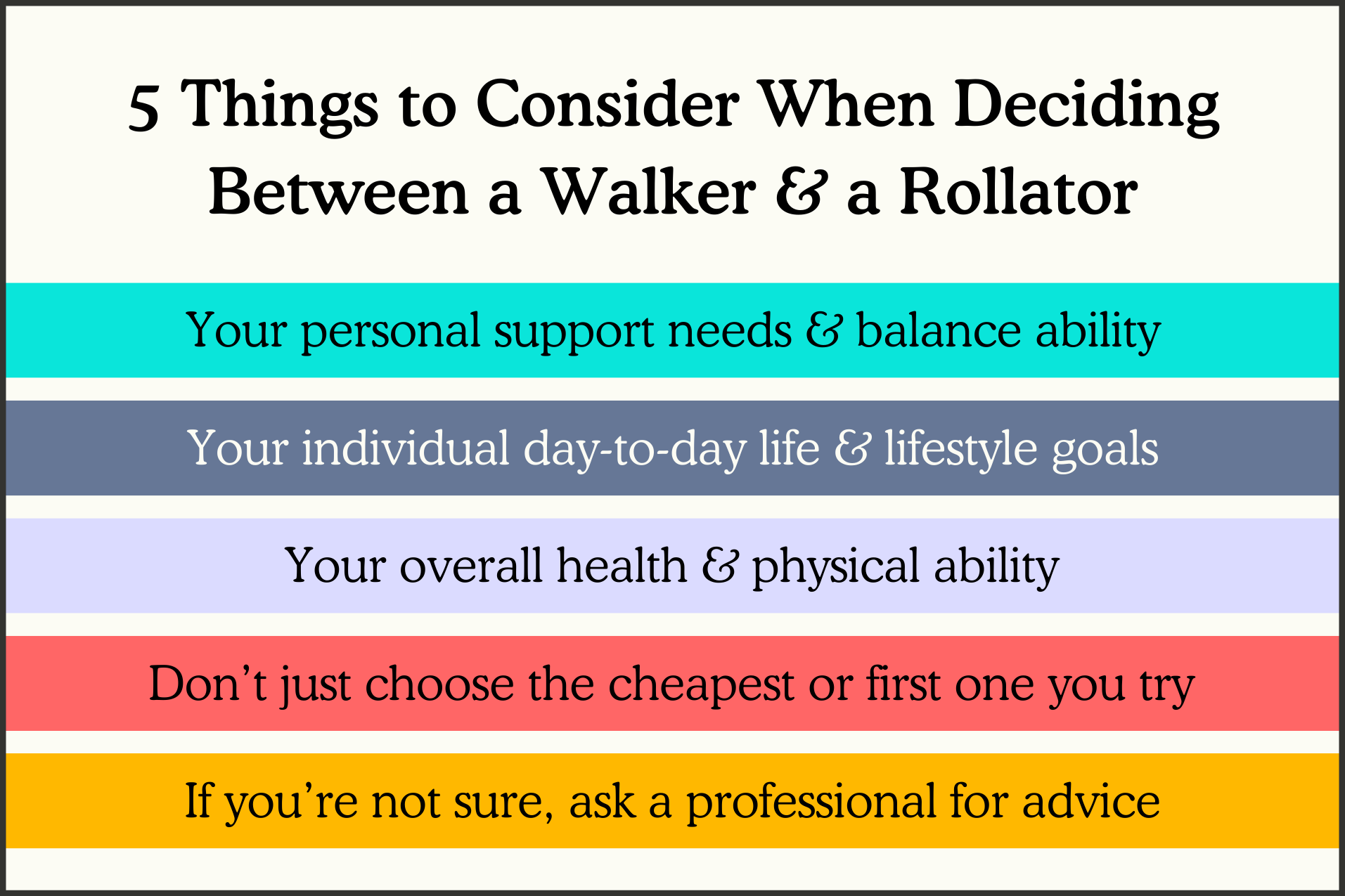
How to Choose Between a Walker and a Rollator
Consider Your Balance and Support Needs
Your choice should align with your balance and support requirements; walkers are ideal for those needing substantial support, while rollators suit those with better balance but needing occasional rest.
Think About Your Lifestyle
Your daily activities and environment play a crucial role. Rollators offer more freedom for outdoor activities, whereas walkers might be preferable for primarily indoor use, especially in tight spaces.
Assess Your Overall Health and Physical Ability
Evaluate your physical condition and any health changes. Rollators require some strength to operate the brakes, making walkers a better option for those with limited hand strength. If you struggle with arthritis in your hands or wrists, you may want to consider a walker over a rollator for this reason. You don’t want to be caught out away from home without the ability to easily use the brakes on your rollator.
Trial and Test Before Committing
If possible, test both types in various settings to gauge which better suits your needs and offers comfort. You’ll want to test indoors and outdoors, on smooth surfaces and uneven surfaces, going long distances, how easy each is to maneuver, how easy each is to adjust, whether or not they fit in key areas of your household such as through narrow doorways or in bathrooms, and whether you have the strength to manage a rollator or if you need the control of a walker.
Seek Professional Advice
Consulting with a healthcare professional can provide personalized recommendations based on your health status and mobility needs. If you are unsure which mobility aid is right for you, consult with your primary care provider to determine which suits your individual needs and lifestyle.

When to Choose a Rollator
Choosing a rollator as your mobility aid is an excellent decision for individuals who place a high value on independence and have an active lifestyle that includes spending considerable time outdoors. Rollators are specifically designed to cater to the needs of users who, despite experiencing moderate balance issues, possess the ability to manage a device equipped with wheels. This ability is crucial for navigating the rollator through various terrains and settings, from smooth pavements in urban areas to the slightly more challenging surfaces found in parks and outdoor recreational spaces.
Moreover, the design of a rollator, which typically includes a built-in seat, offers an invaluable benefit for those who require periodic rests during their walks. Whether it's taking a moment to catch your breath, enjoy the scenery, or simply relax, having immediate access to a seat eliminates the need to find a bench or a suitable resting spot. This feature enhances the user's ability to maintain an active, engaged lifestyle without the limitations that might come from fatigue or the need for frequent breaks.
A rollator is also particularly suitable for individuals who possess good hand strength. The operation of the brakes, an essential safety feature on a rollator, requires the user to apply pressure confidently and securely to control the device, especially on inclines or uneven surfaces. This aspect of a rollator's design ensures that the user can manage their speed and maintain stability at all times, providing a sense of security and control that enhances the walking experience.
In summary, when considering the choice of a mobility aid, opting for a rollator is a decision that supports an active, independent lifestyle, particularly for those who enjoy the outdoors and require a device that offers both support and convenience. Its design caters to individuals with moderate balance, good hand strength, and a preference for having a seat for rests during their outdoor adventures.

When to Choose a Walker
When deliberating on the appropriate mobility aid, choosing a walker becomes a pivotal decision for individuals in need of maximum support and stability. This choice is particularly crucial for those who encounter significant balance challenges, where the grounded, sturdy frame of a walker provides a reliable foundation to lean on and gain support from. A walker is specifically designed to meet the needs of users who require a substantial level of assistance in their daily movements, making it an indispensable tool for navigating through their environment safely.
Moreover, a walker is highly recommended for individuals who struggle with grip strength. The simple yet effective design of a standard walker, devoid of complex mechanisms, makes it easier for users to handle, especially when their hand strength is not at its peak. This feature is vital for those who may experience fatigue quickly, ensuring that the user can rely on their mobility aid without the concern of losing grip or control over the device.
Additionally, for people with limited mobility, perhaps due to recent surgery, chronic conditions, or the natural aging process, a walker can significantly enhance their ability to move around. It offers a degree of independence that might not be achievable otherwise. The walker's frame provides a secure structure to hold onto, allowing users to take measured, stable steps. This level of support is essential for those who find walking unaided a challenge, ensuring they can maintain some level of physical activity and autonomy.
Is a Rollator or Walker Better for People with Balance Problems?
For severe balance problems, a walker is typically recommended due to its stable, grounded structure. Rollators, while offering mobility and independence, might not provide the same level of support for those with significant balance challenges.
In conclusion, the decision between a rollator and a walker is deeply personal and dependent on individual needs and lifestyles. By understanding the differences and assessing your own requirements carefully, you can choose a mobility aid that not only enhances your independence but also fits seamlessly into your daily life. Whether you opt for the stability of a walker or the flexibility of a rollator, the goal is to safely support your mobility and enrich your quality of life. Always consider seeking professional advice to guide your choice, ensuring that the mobility aid you select is the perfect match for your needs.


